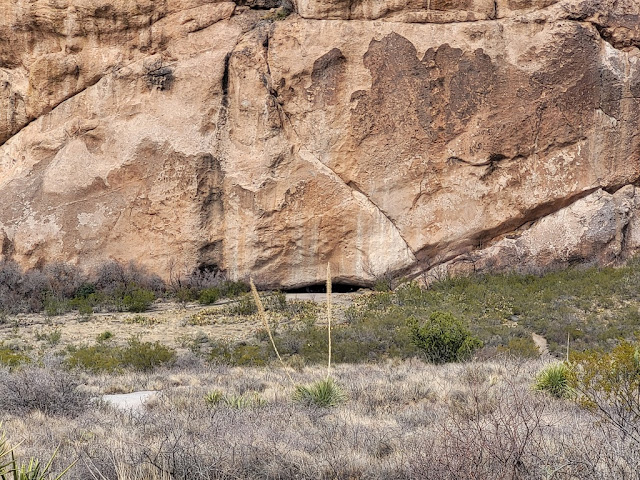We decided to give up on our idea to visit the Carlsbad Caverns when we found out that it is necessary to reserve a time – and no time slots were available until Monday afternoon. Had the weather forecast been better this wouldn't have mattered much, but it was supposed to turn colder and windy with an increased probability of rain. It looked better further west, and we headed out that way Saturday morning after another great Mexican breakfast at “El Alamo”.
The hiking trail we had abandoned a few days earlier near Las Cruces was on the way to Columbus on the Mexican border, our destination for the night, and since there was no rain in the forecast we chose that as our hike of the day. Without any trouble we found the A.B. Cox visitor centre in the Dripping Springs natural area, checked in there to make sure we had the right trail, and were on our way early in the afternoon.
This is an easy in-and-out hike, about a mile and a half each way, with a slight but steady incline on a wide trail. At one point it was used as a road to get to the springs – or more accurately the Van Patten Mountain Camp built nearby in the late 1900s, a resort with 32 guest rooms, dining hall and entertainment popular with well-to-do visitors and New Mexico State University students for several decades. It's easy to see why this would have been a favourite destination: the location is gorgeous, tucked right into a fold at the foot of the Organ Mountains, secluded yet reachable without too much effort first by horse or horse-drawn carriage, later by automobile.
Not much is left now, mostly some remnants of brick walls hard to discern from the surrounding rock from a distance. It's a lovely place to have a picnic even now, quiet, surrounded by majestic mountains, yet with an amazing array of plant life, from piñon pine and juniper to agave and yucca, creosote and acacia to small herbaceous plants and cacti. A bit further along the trail are the remnants of another venture, a 'sanatorium' built by a Dr. Boyd used for a few years for patients with tuberculosis and other lung ailments. Here, the buildings are more intact and, like the former mountain camp, protected as national heritage.
 |
| The 'dripping springs' |
When we returned to the visitor centre we had enough time to do another short hike to 'La Cueva' (The Cave), used by the Jornada Mogollon people around 5000 years ago already. Their artifacts – pottery sherds, stone scrapers, manos (grinding stones) and projectile points – have been found in excavations in the area. The roof of the cave, which is not a true cave but rather a shelter in the rock, is blackened from centuries of fires. It must have been a great location, well protected, with water nearby and a good view of the valley below. A slickrock 'ramp' leads up to it, with several deep grinding holes.
We left mid-afternoon and took I-10 south to El Paso, TX, happy we could leave big cities behind soon after: we now took the CR9 west towards the village of Columbus, about an hour's drive on a narrow, little-travelled road hugging the Mexican border. Here, we saw the much-talked about 'wall' for the first time and were reminded of the wall dividing Germany which we knew from our childhood and youth, only that this is not wall but more like a fence. We were to see it closer up the next day, but more about that later.
We arrived shortly before sunset, the landmark water towers outlined against the glowing sky, our beautiful small adobe hotel 'Los Milagros' (Miracles) welcoming in the evening light.














No comments:
Post a Comment